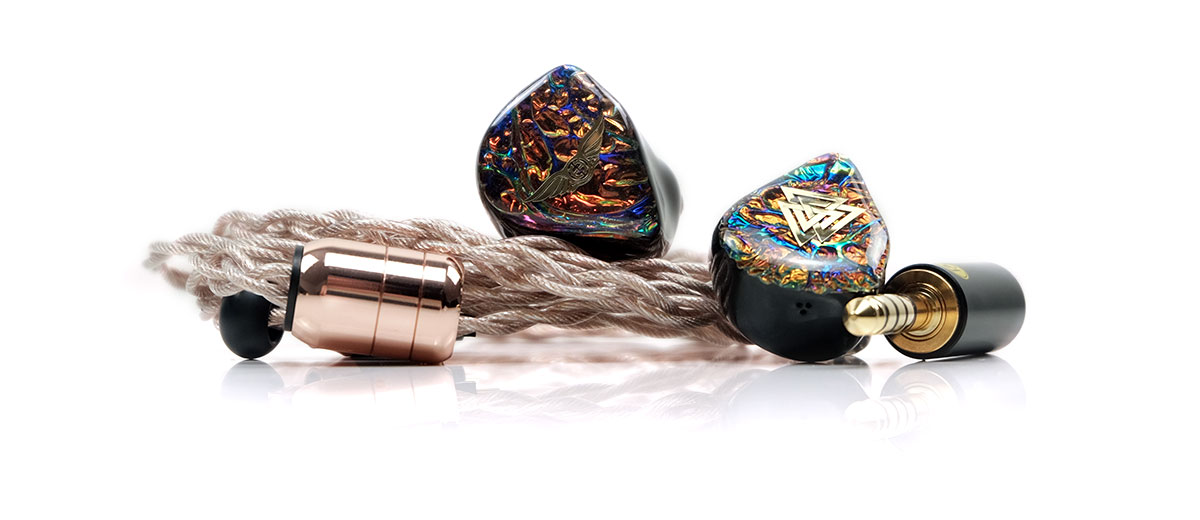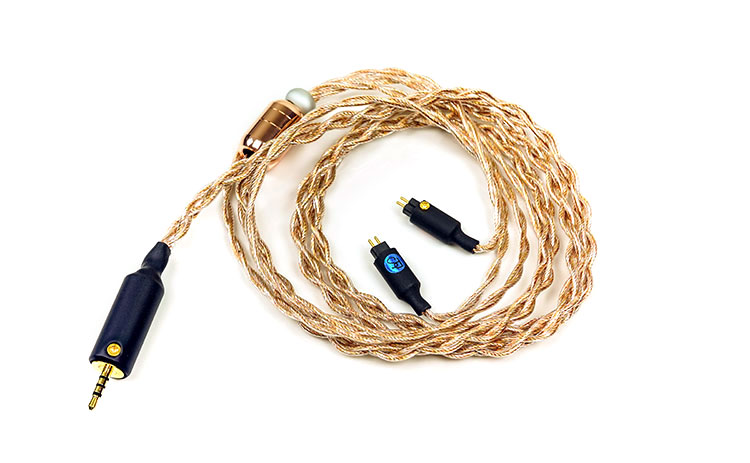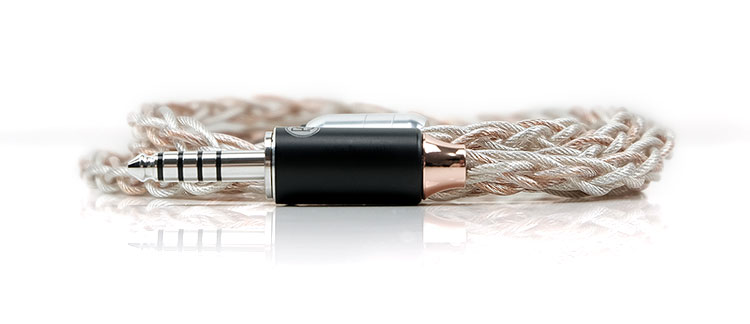Synergy
Because of the relatively strong effect on the timber of our paired monitors, the Quad-Copper is one of the easier cables to decide what IEM to pair it with.
At a high level, I would be aiming for any monitor that you find enjoyable with a bit of enhanced bass snap and physicality in lower register instruments as well as enhancing the texture and girth of vocal performances.
Less so if you want the treble to become more predominant on your chosen pairing though I do find it a step up on the Tri-Copper’s more relaxed highs.
You might also want to pick the Quad-Copper if you want to take the edge off some IEM’s treble performances that could come across as too bright or forward-sounding.
For example, the Softears RS10 and Noble Audio Kublai Khan have two very contrasting sound signatures but both sounded very smooth and beefy with the Quad-Copper pairing.
Both have a clean treble and whilst the RS10 is not as weighty on the lows compared to the dynamic driver inside the Kublai Khan it does sound denser and more impactful when paired with some of PLUSSOUND’s alternative choices such as the Tri-Copper and the Tri-Hybrid.
The Quad-Copper/Viking Ragnar pairing does a similarly impressive job of fleshing out the lows and introducing a little bit of necessary softness to the EST highs to get the balance more to the euphonic side.
Fans of the Empire Ear’s Odin looking for a cable that doesn’t overcook the upper mids and lower treble should give the Quad-Copper a demo also. It fleshes out that dynamic driver beautifully, introducing a bit more warmth in the lower mids compared to its stock cable, and pulls back a bit on the lower treble bite.
Select Comparisons
All comparisons were completed using the Noble Audio Viking Ragnar, Softears RS10, 64 Audio’s tia Trio, and the Empire Ear’s Odin with stock tips. Sources included the HiBy RS8 and the HiBy R5 Gen II.
PLUSSOUND Tri-Copper
$549.99
The PLUSSOUND Tri-Copper is the original cable upon which the limited edition Quad-Copper is based. It was reviewed by us way back in 2018 and you can read our full review of the Tri-Copper here.
Technical
Both cables have UP-OCC copper, silver-plated copper, and gold-plated copper wiring with the Quad-Copper adding an additional palladium-plated copper element.
Though nominally they are both 4-wire 26AWG Type 6 Litz geometries, the Quad-Copper version is tweaked with two bundles of every material per main Litz bundle instead of the Tri-Copper’s single with proprietary dampening cores in each wire.
In theory that should make the Quad-Copper a softer cable for handling but for my own testing that is almost by default since PVC can get stiffer over time and it’s been 5 years since my Tri-Copper sample was made.
Design
My particular Tri-Copper cable is fairly dated now in terms of where PLUSSOUND is with its cable designs. Still, it’s a good benchmark to see how far they have come with their finishing.
Back then it was more heat shrink wraps and hot press labels on the side of the barrels. Now its rose-gold hot-stamped metallic heat shrinks and upgraded barrels on both ends with that same reliable screw-lock aesthetic on the side.
Other minor details include a low-profile black dust shield on the top of the splitter and the addition of a chin cinch which was not on the original.
Of course, you can get all the Quad-Copper finishing now on the latest Tri-Copper cable which might make them fairly indistinguishable in terms of handling and looks.
One final note, the Tri-Copper sample I have is a 5-year-old cable and PVC tends to get a bit firmer over time. So naturally, the Quad-Copper PVC is much the softer of the two and it shows in the slightly more relaxed nature when unrolling or handling it.
Neither the Tri-Copper nor the Quad-Copper will give you any issues in terms of microphonics or unreasonable memory retention.
Performance
The differences between these two 4-wire copper cables hooked up to the tia Trio were more than surprising.
Possibly in every way the Quad-Copper outperforms the Tri-Copper. We are talking about better dynamic range, a heftier low-end, and a richer more vivid-sounding vocal performance.
I was expecting the additional palladium to perhaps tone down any treble presence but if anything, the Quad-Copper gives it a firmer clearer set of highs on the tia Trio.
One thing is for certain, the blacker background was much easier to pick up using both the resolving RS8 and even the mid-fi R5 Gen II balanced output as sources. I had to double-check with the R6 MKII as my old Tri-Copper cable is 2.5mm TRRS terminated and some adaptors can mess a little with resistance levels but the outcome was much the same.
The original Tri-Copper is much more relaxed and softer in its delivery throughout the tia Trio FR. The basic coloration is not hugely different, both are veering to the warmer and richer side but the Quad-Copper just has that better dynamic snap, improved instrumental imaging, and improved space around each instrument.
Vocals get much the same treatment sounding a little firmer and more detailed and like the low-end, the peaks and falls, (dynamic range) of each note have a much greater level of impact.
The Tri-Copper is still a very good cable but either PLUSSOUND improved the conductivity of their plugs immeasurably since those old 2.5mm plugs on mine or the new double bundle geometry is letting a lot more information through to the drivers. Either way, the Quad-Copper is an improved cable.
PLUSSOUND Copper+
$999.99
A more recent release and the first of PLUSSOUND’s new “Plus” series including the Silver+ and the Award Winning Hybrid+. You can read our full review of the Copper+ here.
Technical
The Copper+ is much simpler in terms of the mix of elements but way more complicated for its geometry compared to the Quad-Copper.
Instead of 4 different types of copper rated at 26AWG in a double bundle Type 6 Litz, the Copper+ uses only UP-OCC copper but with a bigger gauge rating of 24AWG.
The Copper+ geometry is an inner conductor and an outer shield sharing a geometric axis. You get a single twist Litz configuration and then an outer layer of more UP-OCC copper but this time they are 5-strand bundled in a Litz configuration.
In between the new copper Litz geometry, there is a second clear type layer of PS insulation to isolate the inner from the outer layer. You then have a main PS insulation jacket wrapped around that outer layer.
All of this makes this bad boy a shade on the bulkier and stiffer side as you will read more about below.
Design
I love the aesthetics of the Copper+ but in terms of handling, the Quad-Copper is softer and more flexible when in use or in the hand.
You can get the Copper+ in both a braided and a twisted format and this one follows the latter rather than the former. It actually makes the volumetric size of the cable thinner than the braided Quad-Copper but at the cost of comparative stiffness.
You also get a little more microphonics in the Copper+ and it is a little heavier around the ear compared to the Quad-Copper when in use.
Memory retention on both cables is quite good, both are fairly well disciplined with the Copper+ doing a lot better than you might think for a ‘fatter wire’, partly due to that twisted finish.
You can get both cables in almost the exact same finishes and indeed that is exactly what I have here with both using a rose-gold splitter, hot-stamped metallic heat shrinks, and black barrelled 4.4mm pentaconn terminations.
Personally, I think both look really good with the stealthy Copper+ black and gold contrast or the harmonious rose-gold tones of the Quad-Copper cable and barrels.
Performance
Both the Copper+ and the Quad-Copper are heading in the same direction with a smoother-sounding presentation and more to the warmer side with our tested pairings: the Noble Audio Viking Ragnar and the Empire Ears Odin.
However, on the technical side, you can tell where the Copper+ shines a little bit more compared to the Quad-Copper which should be no surprise given its heavier gauge rating.
You get a more expansive and deeper sound stage for a start with improved treble presence and a slightly better perceived level of refinement on the quality of the timbre from the notes.
You could argue that the Copper+ is slightly more relaxed on the low end and sweeter in its mids timbre with the Quad-Copper sounding denser on Odin’s dynamic driver. Particularly on the lower mids which can often be a weak point in Odin’s armor.
However, the Copper+ bass allows for a little more resolution and sounds more expansive on the lows in general. Not just in the textural detail but also in any little subtle background notes or aftereffects from the instruments such as plucks or guitar knocks.
The perceived lift in dynamic range from the Copper+ can be heard in both the Ragnar and the Odin with the resulting presentation sounding the more resolving of the two cable pairings.
The Quad-Copper will give you something close to the Copper+, perhaps with a bit more punch, and may well be preferred for dialing back on Odin’s more fatiguing lower-treble presence.
PLUSSOUND Tri-Hybrid
$899.99
The PLUSSOUND Tri-Hybrid was launched around mid-2021 and like the Quad-Copper it’s a fairly exotic mix of wire elements. Priced at just a shade higher you can read our full review of the Tri-Hybrid here.
Technical
The Tri-hybrid is a 6-wire 26AWG X6 creation, (or the one we have here) but it should not be understood as 3 mixed elements per wire compared to the Quad-Copper 26AWG 4 copper elements.
Rather, it is a ‘triple triple’, meaning 2 Type 6 Litz wires of each triple metal blend to give you all 3 tri-blends in one cable. With me so far?
At a high level, you have 6 26AWG wires, each wire is split into 2 wires of each group of metal and each group of metal has 3 different metal elements.
You get 2 wires of Tri-Silver, 2 wires of Tri-copper, and 2 wires of T-metal. Tri-silver consists of pure silver, gold-plated silver, and palladium-plated silver which was first seen in PLUSSOUND’S Tri-Silver cable we reviewed back in 2019.
Tri-Copper consists of another 3 elements, this time with copper as the base including UP-OCC copper, silver-plated copper, and gold-plated copper which is 3 out of the 4 elements inside the Quad-Copper.
The final two wires have a triple element T-metal, a mix of traditional gold-plated copper, silver, and gold-plated silver. Of the three, the T-Metal blend is the cheapest element of the various material mixes inside the Tri-Hybrid.
Design
Because it is a 6-wire sample the Tri-Hybrid is thicker and slightly stiffer than the Quad-Copper 4-wire.
Both have the same inherent design properties though with a classic tight short braid throw, low-profile internal strain relief, and PLUSSOUND’s updated splitter and barrels constructions. The only difference is both the thickness and the finishing colors which are entirely down to you.
In the case of the Tri-Hybrid sample here, that’s a silver aluminum splitter with a matching trimmed anodized aluminum chin cinch with those rose gold metallic heat shrinks on top of all the black connector barrels.
It is not as harmonious looking as the all-rose-gold Quad-Copper finish but it complements the mixed colors in its wiring mix.
Because it is thicker, the Tri-Hybrid’s weight will be felt a bit more around the back of the ear than the lighter 4-wire Quad-Copper which I could barely feel.
Mind you, the Tri-Hybrid is a little more disciplined around the back of the ear whereas the moveability of the Quad-Copper 4-wire design might suit those who wear glasses a bit more.
Performance
There is very little perceived difference in dynamic range and volume between these cables with our two test monitors, the Softears RS10 and the Tia Trio. That is saying something considering the Quad-Copper is a 4-wire 26AWG and the Tri-Hybrid is a 6-wire 26AWG geometry.
However, in terms of coloration, they do differ markedly. The Tri-Hybrid pairings have a bit more upper-mid presence and treble shine compared to the Quad-Copper with a corresponding neutral low-end in terms of impact and sub-bass presence.
Whereas the Quad-Copper was warmer, a little more rounded, and heavier on the low end. That was with both monitors but especially for the RS10 which I have always regarded as having a unique and punchy bass for an all-BA design.
That being said, the RS10 did feel a little more resolving and cleaner in its delivery of those mids and highs using the Tri-Hybrid. Higher-pitching vocals sounded a little brighter and that gave them a more subjective presence, especially with the bass weight dialed down a bit.
The Quad-Copper was comparatively more relaxed through the mids and highs though by no means attenuated or rolled off. It prefers to beef up the body so both monitors will sound more powerful and fulsome pulling your ear more to the bass and lower-mids performance.
I would personally pair the Tri-Hybrid more with monitors high on resolution and if you want a bit more focus on the mids and highs. If you need more weight, body, or warmth in your IEM then the Quad-Copper is the right pick.
Our Verdict
It is a bit of a shame that the PLUSSOUND Quad-Copper is a limited edition release because it crushes the older Tri-Copper in terms of dynamic range producing a more vivid and exciting sound signature for a wider range of monitors.
It’s not a subtle coloration, it wears its heart on its sleeve so to speak which makes it a very easy cable pairing to identify with in terms of its ideal target market.
If your preference is to try and squeeze a bit of additional bass weight and slam or add some pleasing saturation and warmth to a vocal delivery then the Quad-Copper should be right up your alley.
All of that comes wrapped up in PLUSSOUND’s typically excellent build quality which I can testify will last you a lot longer than some competing cables in terms of plug-and-pin durability.
PLUSSOUND Quad-Copper Specifications
- Overall Length 4 ft / 48 in / 1219.2 mm / 121.92 cm
- 26 American Wire Gauge (AWG)
- Wire Type UP-OCC
- Construction Type 6 Litz





